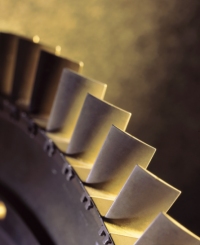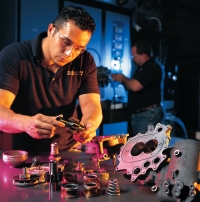It was not without irony that The Great PMA Debate was held in the Royal Aeronautical Society's Bill Boeing room, where the air conditioning was not the only thing chilling the marrow of the average aerospace manufacturer.
What is so new about sourcing alternative aircraft parts instead of getting them from the original manufacturer? The design and manufacture of spares goes back to after the Second World War, when a US Federal Aviation Administration programme known as "Parts Manufacture Approval", or simply PMA, helped get a large number of old military aircraft, sold to the civilian market, airborne again.
 |
|---|
Fifty years on and an industrial expedient has evolved into a barely concealed blood-fest with PMA parts businesses posing a mortal threat to the livelihood of original equipment manufacturers whose aftermarket sales revenue streams are more often than not highly lucrative - if not the only - sources of profit.
OEM engine manufacturer Pratt & Whitney's 2006 announcement that it was to enter the PMA market with parts for its competitor's CFM56-3 engine was a bold move that put CFM International, the General Electric and Snecma joint venture, on its guard.
The FAA earlier this year granted P&W parts manufacturing approval certification to produce high-pressure turbine shrouds for the CFM56-3, with the manufacturer seeking FAA certification for another 47 PMA parts for the same engine by the first quarter of 2008.
At the London event, which brought all sides of the debate together, Rick Deurloo, P&W director of sales and marketing, said that by early October the 48 "high dollar" engine parts would be in the USA after having been cell tested in Stavanger, Norway, ready to be flight tested on a Boeing 747.
Nineteen of those 48 essentially critical components will need a supplemental type certificate (see box) because they have undergone significant design changes.
What that status also confers is that P&W becomes the manufacturing authority and will therefore apply directly for approval from the FAA in the USA and the European Aviation Safety Agency, prompting many to ask whether the totality of critical components constitute a P&W56 rather than a CFM56.
Deurloo explains that the move from an engine OEM into a PMA market was motivated in large part by customer demand. "That drove P&W to do something different, but something over which it could determine its success. It both complements our existing aftermarket and allows for growth going forward," he says, adding that the move also opened up market areas where it had had no presence for years such as Southwest Airlines and Continental.
Leverage
"It's been a very steep learning curve for us, but we recognise more than ever before how vital this is to the industry. It's something that will establish its position in the marketplace through the level of demand. We are treated by the airlines in a way that we never have been before. Airlines are either going to take advantage of PMA or use it as leverage with the OEMs," says Deurloo.
He notes that many in the industry have expressed concern that P&W's move into the PMA market is camouflage for a price-correcting ploy. After so long giving engines away practically for free and relying on the lucrative aftersales revenue stream, P&W - with its aspirations to develop the next-generation geared turbofan - is trying to force a market correction by changing the balance of what airlines pay for engines and what it pays for support.
P&W aside, increased pressure forcing PMA to come of age - albeit a tardy maturity - is coming from the much more positive attitude of European operators, highly visible in their recent signing of development agreements with PMA manufacturers.
British Airways admits to looking to make massive savings by using PMA parts. Ameet Bhalla, BA's technical manager, airframe systems, explained to delegates at the London event that the strategy follows a deal signed in May with Heico, the world's largest independent designer, manufacturer and distributor of FAA- and EASA-approved replacement parts for jet engines and aircraft components. This will see the Florida-based business exclusively manage BA's alternative parts programme, helping the airline maximise savings. "Through this deal with Heico, we will actively seek PMA opportunities going forward. We will no longer be the cash machine for OEMs," said Bhalla.
"These are not bogus parts, but approved by the very same regulatory authorities that approve OEM aircraft parts. BA reviews all applicable PMA parts and approves each one on a case-by-case basis. Once installed, the parts are monitored for any defect trends and we note failure modes of PMA parts to check that they are similar if not the same as their OEM equivalent," said Bhalla, who added that the airline will now focus on exploring the potential of the 95% of Heico's inventory that are non-critical items.
James Bennett, Heico European sales director, adds: "Historically, BA, while not anti-PMA, could not be said to be advocates either. They are well known as being an extremely conservative airline, but the recent move by German flag carrier Lufthansa [a stakeholder in Heico] was seen in the industry as an extremely successful move to keep the OEMs in check."
If the potential cost savings for the airlines operating large aircraft are significant, the relative savings for the regional air transport industry are even more compelling, operating as the sector does with aircraft that carry fewer people, but which still generate the same maintenance and operating costs.
Antonis Simigdalas, Aegean Airlines chief operating officer and president of the European Regions Airline Association, which jointly organised the event with the IBA Group, says: "The world has suddenly become very hostile to the regional air transport industry. The PMA issue is indicative of how our industry responds to issues that concern safety. Is there a possibility that [the PMA detractors] may be overdoing it a little? Surely there is room for compromise from both ends of the perspective, which could both increase operating margins and even perhaps improve safety."
Carl Pedersen, president of Cimber Air Support, acknowledges that PMA has long been a subject close to his heart. "Why use them? The answer is clear. With increasing costs of maintaining aircraft, engines and appliances, PMA parts offer up to 70% savings when comparing OEM and PMA manufacturers. There is also an issue of parts availability due to increased lead times from the OEM.
Cost savings
"PMA is more relevant than ever when operators are forced to look everywhere for cost savings without putting safety at risk. And yet, whenever the use of PMA parts is up for discussion, the individual who tables the issue is often looked upon as the bad guy of the movie, which in my mind indicates that the subject of PMA is not fully understood," he says.
EASA gives automatic approval to PMA parts - but only if they are not critical components they have been manufactured under licence that any minor design changes or more major supplemental type certification meet specific EASA approval.
Pedersen says there is a glimmer of hope in that the issue of PMA may be included in the forthcoming US/EU Bilateral Air Safety Agreement, although some suggest that this is mired in political ramblings over fees and charges. "A European equivalent would in my opinion be welcome, putting the European operators and MROs on an even footing with our colleagues from the USA, eliminating the unfair trade limitations we have today. Certainly this must be of the utmost interest to the EU and therefore also EASA," he says.
EASA has been hatching plans for a European PMA equivalent with a working title of an "EPA" part. A tender to review this has been commissioned, although progress has been slow. Yves Morier, EASA's head of product safety, says EASA is committed to talks with its counterparts at the FAA on how best to co-operate. "There is certainly no statistical evidence for safety concerns with PMA. However, the overall experience may not be sufficient to draw definitive conclusions," he says.
|
|---|
Heico will provide PMA parts to British Airways |
Chris Carter, from the FAA's aircraft certification service, says that as far as the administration is concerned there is no "better than" or "safer than" in the terms of product superiority and that the absolute safeguard of industrial regulation is the only bar that is required. "It's not going away, that's for sure. It's deeply embedded in our system there is an ever-growing demand, the PMA industry is maturing in its capabilities and responsibilities and the regulatory authorities are refining their approval processes and extending delegation," he says.
There remains major resistance from the leasing community. PMA supporters say that a PMA part should be fully recognised as an approved part and that aircraft lessors should be satisfied with including "only approved parts are to be used" rather than "no use of PMA parts" clauses within lease agreements.
P&W's Deurloo expects things to shift in the next six months, with airlines driving the demand for more flexibility in their leasing contract terms. "We have visited many tier one and two leasing companies. Their initial reaction was a little more neutral than we were expecting and their concerns really centre on marketability and residual value moving the aircraft around," says Deurloo.
There is, however, no tangible upside for an aircraft leasing company. From a risk perspective their principal concern is that if one airline puts PMA parts on a lessor's aircraft assets, and then that aircraft is offered to another airline customer wedded to OEMs, that is one deal that will never see ink. Jon Sharp, chief executive at engine lessor ELFA, says: "It's a very simple equation. If only 50% of my customer base wants PMA parts in their engines, then that reduces my market by 50%, directly reducing the economic value of the asset.
Worrying the OEMS
"OEMs are extremely concerned about PMA as it puts their whole strategy of lifetime spare sales at the point of sale in jeopardy. The key thing about the manufacturers' share of the MRO market is that in the last 10 years they have tripled their market share through aftermarket protection using guaranteed costs schemes," says Sharp. He places the blame with the manufacturers. "They're the ones causing the problem downstream for everyone else, independent MROs, non-OEM parts suppliers and leasing companies," he says.
PMA is OEMs' biggest challenge going forward. "It's either going to be the death knell of a dying animal or a game changer," says Sharp.
Diarmuid Healy, powerplant programme manager at the Royal Bank of Scotland, whose lease contracts prohibit PMA, says: "At the moment there is absolutely no upside for us. The issue for us is, who is going to take out the risk of remarketing and residual value of the aircraft? Who exactly is going to do that? It's too huge for the PMA manufacturing industry to do, that's for sure. I would never say never but I just can't see it happening tomorrow."
The FAA's Chris Carter says: "There is a lot of talk about risk but I fail to see where the risk is in the PMA part itself. It is much more about the financial standing of the PMA manufacturer itself." He advocates the introduction of an insurance-type rating scheme based on financial backing and warranty cover, etc.
"The way I see it is that some of these PMA manufacturers are attaining the scale and stability of many an OEM."
Source: Flight International
























